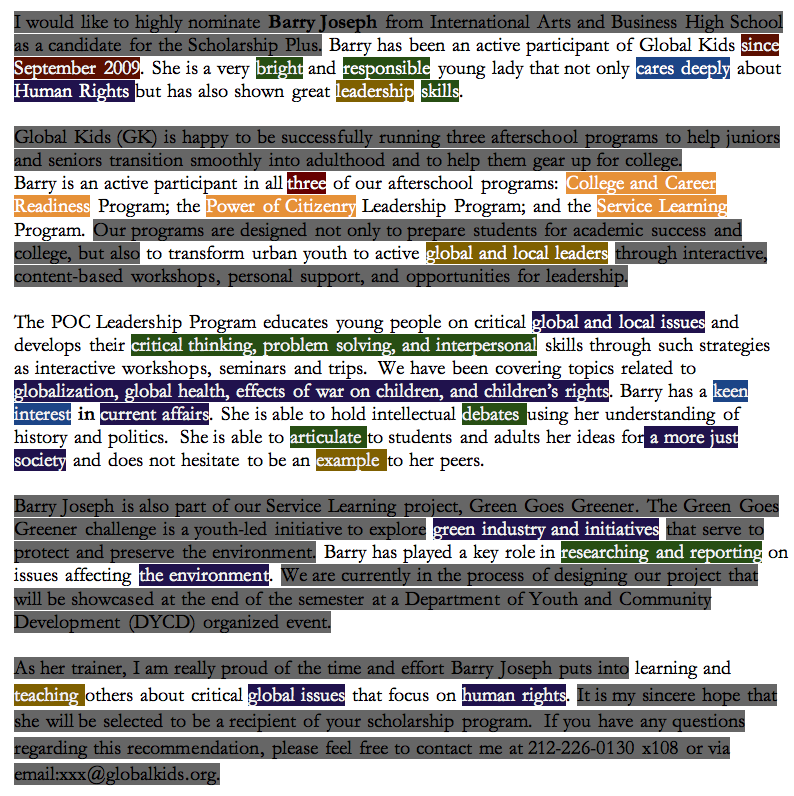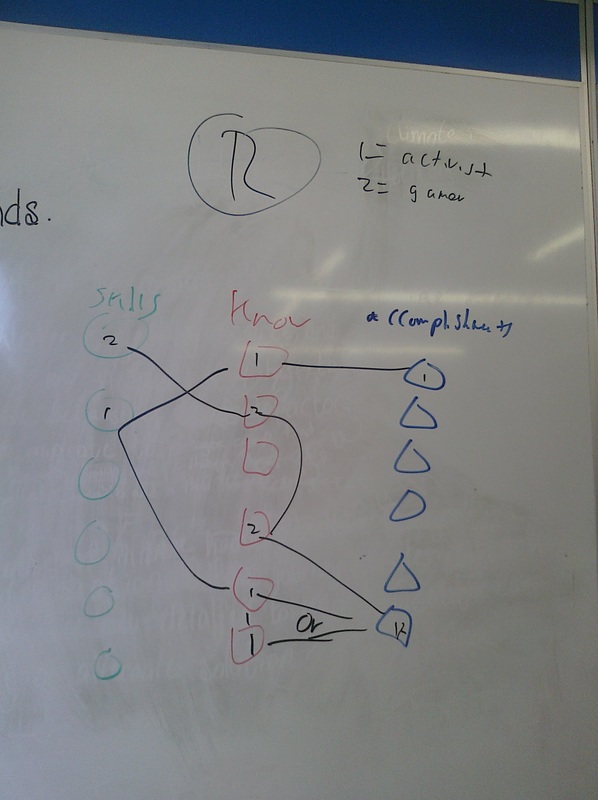We started off sharing the results of our homework. First some staff “interviewed” their kids and spouses about the games they played and the badge-like features they encountered; we compare and contrasted that with our understanding of how our “badges for learning” plans related to game mechanics.
Next I shared the results of taking a random Letter of Recommendation and then color coding it for every mention of an accomplishment, hard skill, soft skills, knowledge, roll played, or program within which they participated. It was an unexpectedly rich vein. Thirty different mentions were identified. Noticing how well the categories worked, and wondering if every Letter would offer the same balance amongst them, led to lots of interesting conversation. It suggested that working with GK youth leaders to code dozens of other Letters will be a useful entry point for them to engage in developing the GK badges. It also suggested that these categories were more than conceptual – they easily lined up to what we think youth learn in our programs. We were on the right track.
We then moved on and spent the rest of our time with the third between-meeting task: building out from scratch a Google doc spreadsheet. Each tab in the sheet was one of the learning categories. We originally began with: knowledge, hard skills, roles, and soft skills. Activities was then added as well. It soon became clear that the list of knowledge areas was virtually endless – we tackle so many different topics in our programs – and could be allowed to grow over time. Yet, at the same time, we recognized we had created earlier in the year a group of 18 overarching topics that could shape the year’s programming (such as Structural Oppressions, Poverty, Globalization, Women’s Rights, etc.) and that this offered an excellent list from which to begin.
Hard skills, roles, and soft skills were fairly easy to identify. Hard skill – public speaking. Role – facilitator. Soft skill – develop supportive relationships with peers. “Activities,” however, posed a challenge. We realized that activities like “speaking to a public official” is not the learning itself, but the evidence of the learning. “Activities” were either evidence to be submitted for a badge, or the descriptions of a mission to earn a badge, e.g. “To earn your public advocate badge, speak to a public official about an issue of concern.” It felt right to remove it but, by doing so, we realized we were still losing something important – anything directly about being in a GK program, such as attending 10 sessions in a row, or completing the entire program. The same was true for the badging system – we needed a way to recognize the first time posting a comment within the system, and other desired activities within the badging system. So we removed “activities” and replaced it with “Participation.” That left us with the following badge categories:
- Knowledge: Badges for things youth know
- Participation: Badges for things youth have done within a generic GK program or within the badging systemHard Skills: Badges for things youth can do
- Soft Skills: Badges for things youth do for/with each otherRoles: Badges for things youth are
- Roles: Badges for things youth are
This led us to discuss a wide-range of issues. Should some roles be leveled, e.g. Junior and Senior Peer Educator? How would adding levels increase work for both youth and staff? Other questions were raised as well, regarding how a badging system might affect our practices. Will badges draw attention to skill differentiation and, if so, will that support more effective collaboration or skill inequity? Will seeing others with harder to achieve badges cause “badge envy” and make a youth de-value their own achievements? Will youth get distracted by the final badge and not appreciate the process it takes to get there? Something these issues had in common is that badging was forcing us to deal in a concrete way with underlying educational issues and tensions that have otherwise remained under the surface. It is not new that some youth achieve at different rates within our program, or that they bring different skills to the table. Each trainer has their own individual practice for dealing with this when it becomes a problem, but usually these issues remain invisible. Badges will bring these issues to the surface in both a visible and measurable way.
Our next step was to figure out how they all fit together. Some badging systems develop themes, and then organize their badges by themes. We thought this would be a good place to start. After many years, we have developed a set of organizational Outcomes and Indicators. I had presumed this would be a valuable tool to suggest a structure to our badging system. To my surprise, I could not have been more wrong.
We wrote the five outcomes on the board and considered if they could each be applied as a distinct category of badges, summarizing them as:
- Graduate HS & College-ready
- Global Awareness
- Leadership
- Civic Engagement
- Global Citizen
However, when we tried to figure out which badges would go under which of the Outcomes, it was not always clear. We ended up getting into semantics that said more about the Outcome process than the badging system, and it just wasn’t useful. We tried to make columns, with the Outcomes at the top, each with it’s own set of badging types (knowledge, skills, etc.). It just wasn’t working, not the Outcomes or organizing them into separate themes. Debating whether a particular skill belonged in any particular theme just didn’t seem that useful, if it could be avoided.
We left the meeting excited with the progress. The homework before the next meeting: flesh and further test out our badging framework by creating a clearer visualization – composed of Role Badges and Achievement Badges, along with Power-ups and Missions. Then create three different use cases, mapped atop the visualization, based on three of the Letter of Recommendations.




No Comments